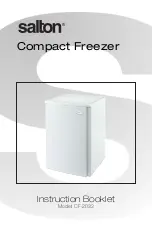
5. Place frozen food into the Freezer as quickly as possible after purchase.
If there are instructions on the packet, carefully follow these instructions
regarding storage times.
6. Carefully select food you intend to freeze; it should be of adequate
quality and suitable for freezing.
7. Use correct packaging and wrap it tight.
8. The packaging should be airtight and shouldn’t leak since this could
cause substantial vitamin loss and dehydration of foods.
9. Foils and bags should be soft enough to tightly wrap around the foods.
10. When preparing foods to be frozen, consider sanitary precautions.
11. Mark packages with following data: kind and amount of foods and
the date of loading.
12. It is most important that the food is frozen as quickly as possible.
13. If the loading amount is too large, the quality of freezing is reduced
which affects the quality of frozen foods.
HELPFUL HINTS
1. Locate the Freezer in the coolest area of the room, away from heat
producing appliances and out of direct sunlight.
2. Let hot foods cool before putting into Freezer. Foods that freeze too
slowly may lose quality, or spoil.
3. Overloading the Freezer causes the compressor to run longer, and uses
more electricity.
4. Freezer storage baskets should not be lined with aluminum foil, wax
paper, or paper toweling. Liners interfere with cold air circulation, making
the Freezer less efficient.
5. Reduce door openings and extended searches, remove as many items
as required at one time, and close the door as soon as possible.
6. If there is a short power interruption keep door closed to help foods stay
frozen. If the power will be out for a longer period of time, check food
before using. If food has thawed do not refreeze.
9




























